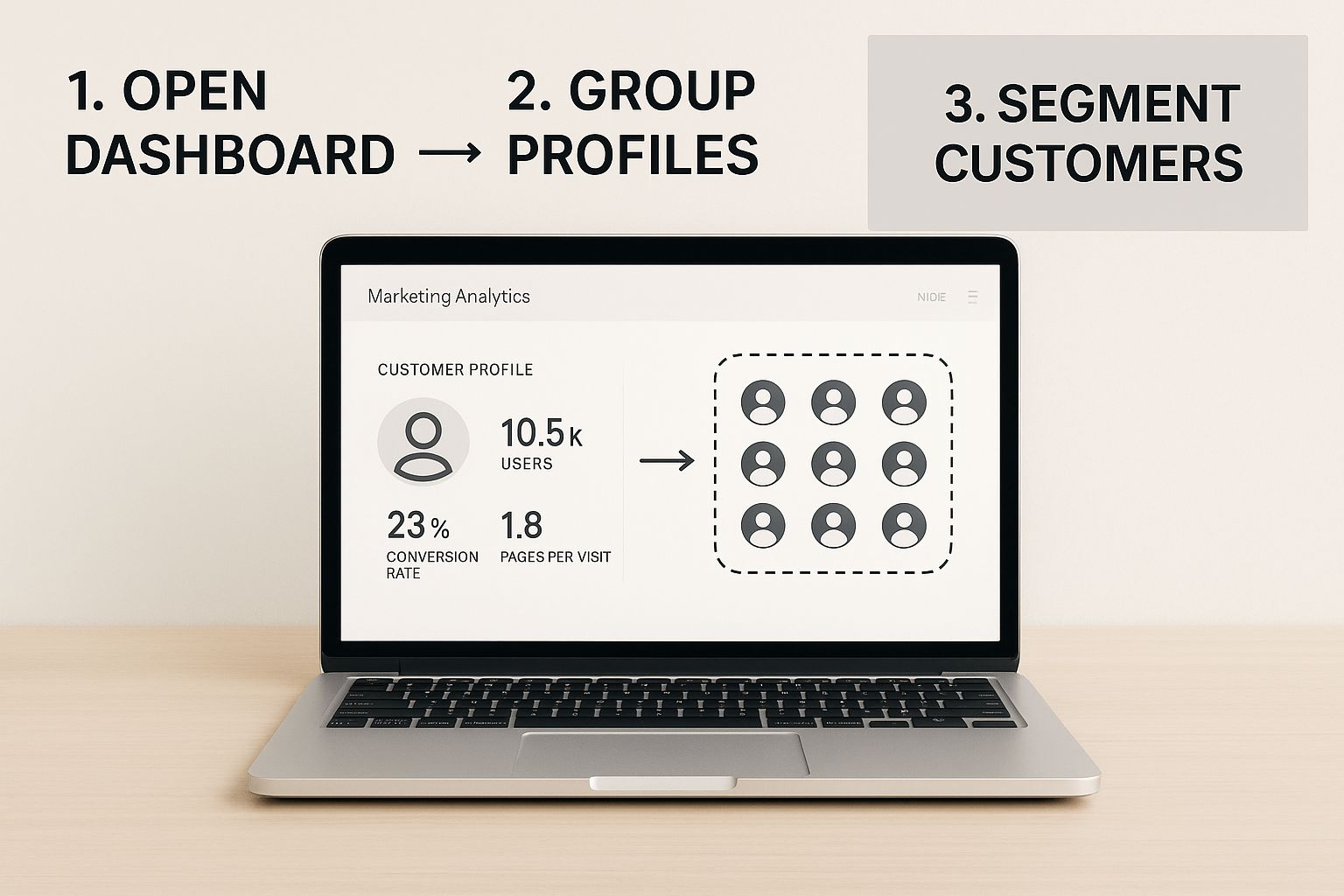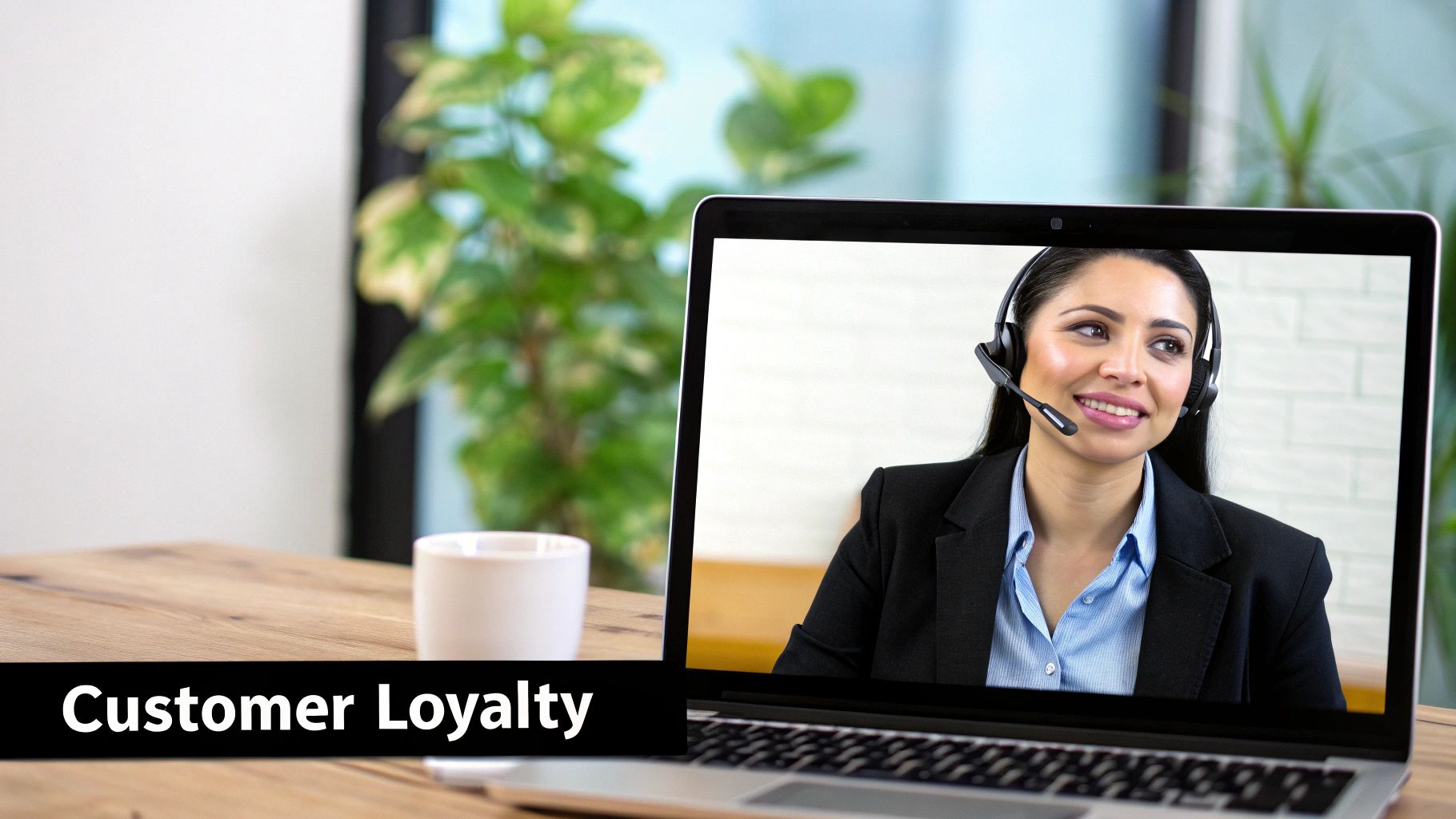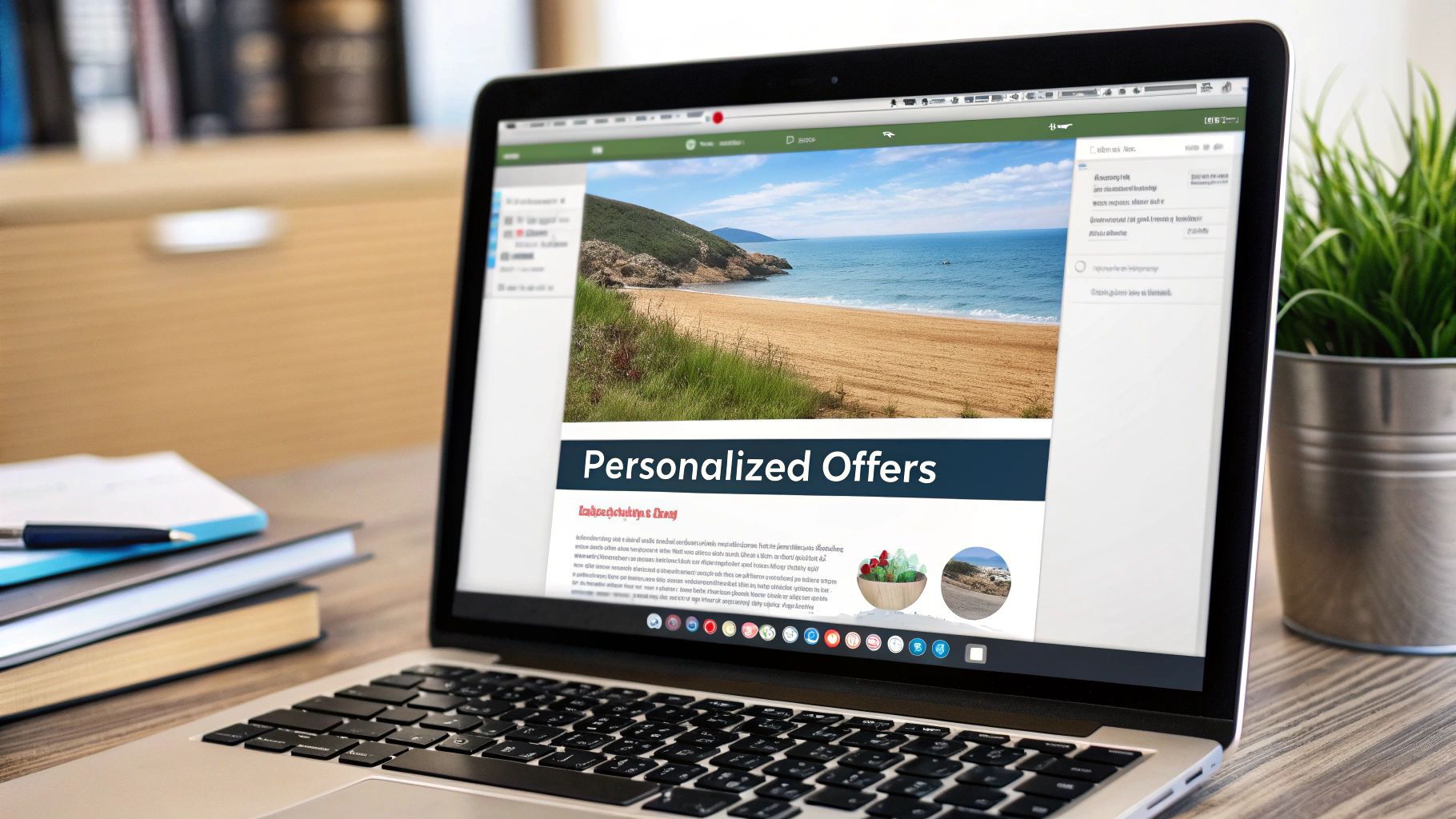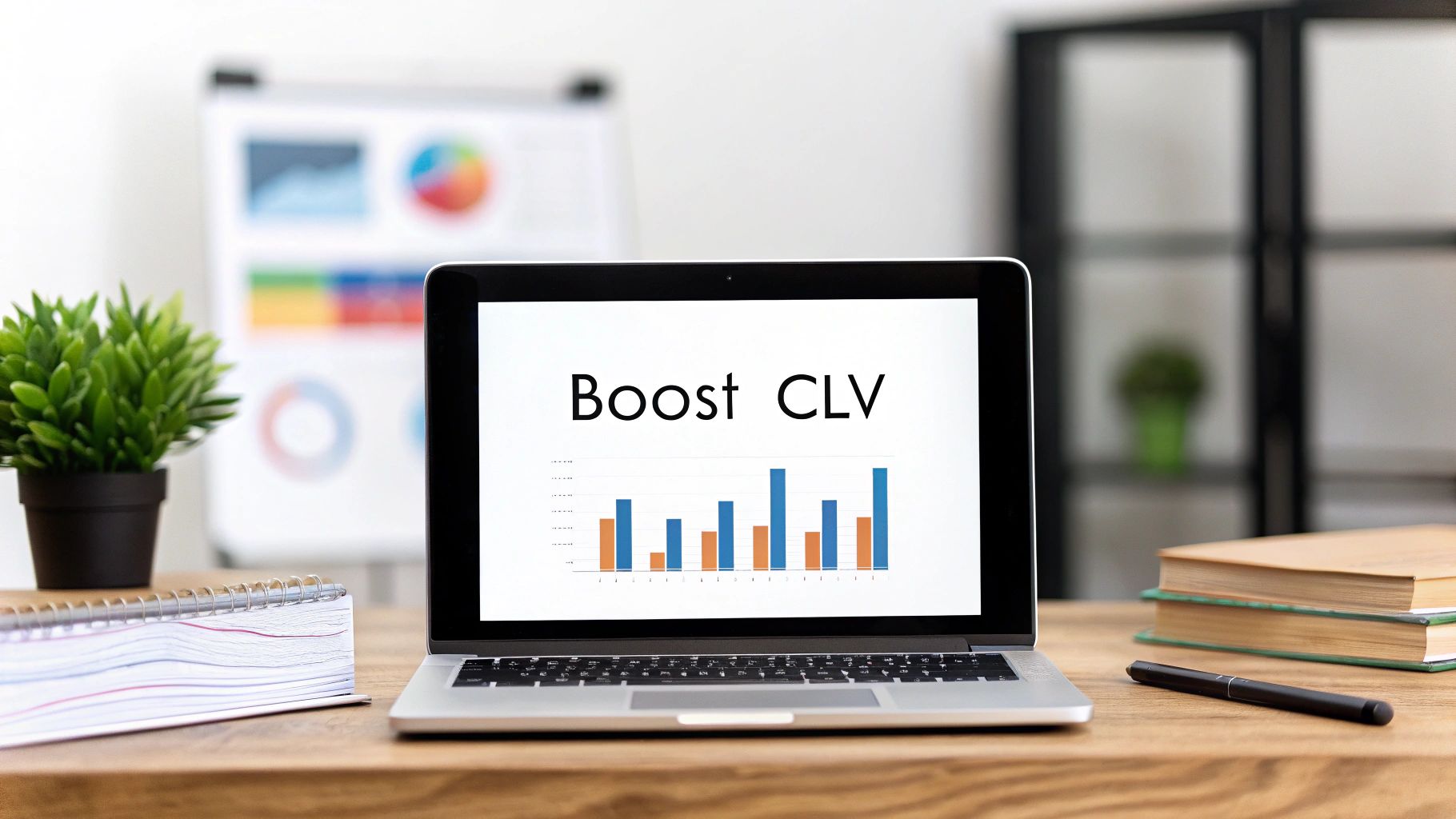It’s easy to get caught up in the chase for new customers. Every new signup feels like a win. But if you want to build a truly resilient SaaS business, the real engine for growth is already on your payroll: your existing customers.
Shifting your focus to Customer Lifetime Value (CLV) isn't just about tweaking a metric. It’s a fundamental change in mindset—moving away from the sugar rush of acquisition to the sustainable, long-term health of your business. The real gold isn't in the first sale; it's in the entire relationship you build with a customer over time.
Why Customer Lifetime Value Is Your Most Important Metric
Think about it this way. Imagine two SaaS companies. Company A throws its budget at flashy ads and lead generation, celebrating a constant stream of new trial users. Company B, on the other hand, invests heavily in world-class onboarding, proactive support, and making sure its current users are genuinely successful with the product.
Company A might see impressive top-line growth at first, but it's a leaky bucket. Company B is quietly building an unshakable foundation. They know that happy, successful customers are the bedrock of profitability.
The Staggering Profitability of Retention
This isn't just a gut feeling; the numbers back it up in a big way. The impact of keeping customers around is almost hard to believe.
Research shows that improving retention rates by just 5% can boost your profitability by anywhere from 25% to 95%. It's one of the highest-leverage activities you can focus on.
Why such a dramatic jump? Because loyal customers do more than just pay their monthly bill. They become your best source for expansion revenue, with upsells and cross-sells accounting for up to 31% of revenue for some companies. For a deeper dive, you can explore more customer lifetime value statistics to see the full picture.
Key Drivers of Customer Lifetime Value
So, if CLV is the goal, what are the levers you can actually pull to move the needle? It’s not just one thing, but a handful of core components that work together. Understanding them helps you see exactly where your efforts will have the most impact.
Here's a breakdown of the core drivers that directly influence a customer's lifetime value and, ultimately, your company's profitability.
| Driver | Description | Impact on CLV |
|---|---|---|
| Average Purchase Value | The average amount a customer pays you in a single transaction or billing cycle. | A higher average purchase value lifts the starting point for every customer, directly increasing their total CLV. |
| Purchase Frequency | How often a customer buys from you or, in SaaS, renews their subscription. | Getting customers to upgrade or renew more often shortens your time-to-profitability and multiplies their value. |
| Customer Lifespan | The total amount of time a customer stays with your business before they churn. | This is the ultimate multiplier. Even a small increase in how long customers stick around can dramatically grow their total value. |
When you boil it down, every strategy we'll cover is designed to positively influence these three drivers. By creating an experience that customers love, you naturally encourage them to stay longer, spend more, and even tell their friends about you—creating a powerful, self-reinforcing cycle of growth.
How to Accurately Measure Customer Lifetime Value
You can't really grow your customer lifetime value if you don't know how to measure it accurately in the first place. When you get a solid handle on this metric, it stops being some vague idea and becomes a real tool you can use to make smarter decisions for your business.
Forget about wrestling with intimidating spreadsheets. At its heart, measuring CLV is all about understanding three core numbers. These pieces give you the full picture of what a customer is actually worth over the entire time they're with you.
The Building Blocks of CLV
To get a baseline CLV, you just need to focus on a few key metrics.
- Average Purchase Value (APV): This is simply the average amount a customer pays you in one go. For a SaaS business, this is your Average Revenue Per Account (ARPA).
- Purchase Frequency (PF): This tracks how often a customer pays you over a set period. In subscription models, this is pretty straightforward—it’s 12 for a monthly plan over a year, or 1 for an annual plan.
- Customer Lifespan (CL): This is the average amount of time a customer sticks around before they churn.
The basic formula ties it all together: (Average Purchase Value × Purchase Frequency) × Average Customer Lifespan.
So, let's say a customer pays $100 a month (APV) and stays with you for an average of 3 years (CL). Their CLV would be ($100 x 12) x 3 = $3,600. It's that simple to get a starting point.
Beyond the Formula to Strategic Action
Calculating your overall CLV is a fantastic start, but the real magic happens when you start segmenting your customers. Knowing the average value is good; knowing which customers are your most valuable is a total game-changer. This is how you stop guessing and start focusing your resources where they’ll make the biggest difference.
This is where you move from just collecting data to using it to group customers by their value, which is a critical step for smart resource allocation.

By segmenting your user base, you can spot your high-value cohorts and treat them like the VIPs they are. It’s how you turn numbers on a screen into a real business strategy.
Your best customers deserve your best efforts. Segmenting by CLV allows you to customize your marketing, support, and retention efforts for maximum ROI. Your top 20% of customers might be driving 80% of your revenue, and they absolutely deserve a proportional level of attention.
From my experience, a good way to start is by creating three simple segments:
- High-Value Customers: These are your champions. Give them premium support, early access to new features, and personalized check-ins. Make them feel valued.
- Mid-Value Customers: This group has a ton of potential. Your goal here should be upselling and cross-selling. Show them how they can get even more value from your product.
- Low-Value Customers: Here, you'll find at-risk accounts or users on basic plans. Nurture them with automated educational content to boost engagement and prevent churn.
This kind of targeted approach is a cornerstone of sustainable growth. You can dive deeper into these https://refgrow.com/blog/customer-segmentation-strategies to get more ideas on how to categorize and engage your users.
And if you want to play around with the numbers for your own business, using a lifetime value calculator is a great next step.
Enhancing Onboarding to Maximize Early Value
You only get one chance to make a first impression. In SaaS, that first impression happens during onboarding, and it really does set the tone for the entire customer relationship. Those first few moments are where a user decides—consciously or not—if they’re in for the long haul or if they’re going to be part of your churn statistics.
If their start is clunky, confusing, or just plain overwhelming, you can bet they'll never stick around long enough to experience the real value your product offers. That lost potential directly craters their lifetime value.

The goal here isn't a feature dump. It’s about creating a clear, direct path to their first "aha!" moment—that magical point where they solve a real problem and see your tool as the solution.
Personalize the Welcome Experience
Let’s be honest, a generic "Welcome!" email feels lazy. You have data on your new user, so put it to work! Ask about their role, team size, or what they hope to achieve during the signup process. Then, use those answers to build a welcome flow that speaks directly to them.
Imagine a project management tool. The experience could be customized like this:
- A marketing manager gets pointed toward a pre-built template for tracking a new campaign.
- A developer is immediately shown how to set up an integration with GitHub or Jira.
- A solo founder is guided to a simple to-do list to get their week organized.
This isn’t complex, but it shows you're paying attention from day one. It makes the user feel understood and immediately boosts their confidence in your product.
Guide Users With In-App Tours
Nobody wants to sit through a 20-step tour of every button and menu. That’s a recipe for overwhelming a new user. Instead, think about contextual guidance. Use tooltips and short, interactive walkthroughs that pop up based on what the user is actually doing.
The real secret is to focus everything on helping the user complete one single, high-value action. For a project management tool, that "first win" might be creating and assigning their very first task. Once they’ve done that, their belief in the product soars, and so does their reason to stick around.
Walk them through that one critical workflow. When they complete it, celebrate! A simple "Success!" pop-up or a bit of confetti animation can build momentum and encourage them to keep exploring. Following solid customer onboarding best practices is one of the most direct ways to build a foundation for a long-term, high-value customer relationship.
Implement Proactive Check-Ins
Don't just sit back and wait for a help ticket to come in. Be proactive, especially in those crucial first couple of weeks. You can set up automated emails that still feel personal.
For instance, if you see a user signed up but hasn't created their first project after 48 hours, that's your cue. A friendly, automated email asking if they need help or pointing them to a 2-minute "quick start" video can be the nudge they need to get going.
These early interventions are absolutely critical. They help you get users back on the right path before minor confusion turns into major frustration. You can dive deeper into building these kinds of helpful sequences in our guide on onboarding best practices. By putting in the effort to create a smooth, successful start, you're not just fighting churn—you're actively building the foundation for a customer with a massive lifetime value.
Building Loyalty Through Personalized Journeys
A great onboarding experience gets customers started, but what keeps them around for the long haul? That’s where the real work of building loyalty begins, and personalization is your most powerful tool. It’s about creating a customer journey so finely tuned that it feels like the product was built just for them.
This isn’t just about dropping a {{first_name}} tag into an email. Real personalization digs much deeper. It means using actual customer data—their product usage habits, past purchases, even their support history—to anticipate what they need next and guide them toward success. When you get this right, it stops feeling like marketing and starts feeling like a genuine partnership.
From Data Points to Personal Connections
Just think about how a service like Netflix keeps you glued to the screen. They don’t just throw their entire library at you. Instead, they curate a custom homepage based on what you’ve watched, what you’ve skipped, and what people with similar tastes enjoy. Your SaaS can, and should, do the same.
By analyzing how someone uses your tool, you can point them toward features they haven't found yet but would almost certainly love. For instance, if you see a customer constantly exporting data to build manual reports, that’s your cue. It’s the perfect moment to introduce them to your built-in analytics dashboard, showing you’re paying attention and want to make their job easier.
This level of attentiveness has a massive impact on retention. In fact, a staggering 82.5% of customers are more likely to buy again from a company that personalizes their experience. That’s a powerful reason to invest in getting it right.
Actionable Personalization Strategies
You don’t need a huge data science team to start building a more personal journey. You can begin with some straightforward, high-impact tactics that deepen customer relationships and grow their value over time.
- Behavior-Triggered Communication: Send messages based on what users do (or don't do). If a user on your basic plan is bumping up against a feature limit, send a helpful tip on managing their usage—and gently nudge them toward the benefits of upgrading.
- Proactive Content Delivery: Don’t make them hunt through your knowledge base. If a customer just enabled an integration, send them a quick guide with advanced tips for that specific tool. You're solving their next problem before they even know they have it.
- Segmented Feature Announcements: When you launch something new, resist the urge to blast your entire user base. Announce it first to the people who requested it or whose behavior shows they'll benefit the most. It makes them feel heard and incredibly valued.
The goal is simple: make every interaction relevant. Customers are happy to pay more for a better experience, and personalization is one of the best ways to deliver it. This changes the relationship from a one-off transaction to a long-term, evolving partnership.
Comparing Personalization Tactics
To make this more concrete, let's look at a few personalization strategies and how they directly influence key metrics that drive up CLV. Different tactics will move different needles, so this can help you decide where to focus your energy first.
Personalization Tactics vs. Business Impact
| Personalization Tactic | Metric Impacted | Implementation Example |
|---|---|---|
| In-App Feature Suggestions | Product Adoption & Upsells | A pop-up suggests an advanced reporting feature to a user who frequently exports CSV files. |
| Lifecycle Email Campaigns | Customer Lifespan & Churn Reduction | An automated email is sent at the 6-month mark with a case study relevant to the customer's industry. |
| Customized Upgrade Offers | Average Purchase Value | A user receives a targeted offer to upgrade to an annual plan that aligns with their usage patterns. |
Each of these tactics strengthens the user's connection to your product by demonstrating that you understand their unique needs.
Ultimately, building these personalized journeys transforms your product from a static tool into a dynamic, indispensable partner. It’s this deep, ongoing engagement that convinces customers to stick around, spend more, and become your most vocal advocates—directly fueling a higher customer lifetime value.
Balancing Your LTV and CAC for Real Profitability
Boosting your customer lifetime value is a fantastic growth lever, but let's be honest—it’s only one side of the profitability coin. If you want to build a SaaS business that actually lasts, you have to get a handle on what it costs to land each new customer in the first place. This is where the Lifetime Value to Customer Acquisition Cost (LTV:CAC) ratio becomes your north star.
Think of this ratio as the ultimate gut check for your business model. It pits the total revenue you can expect from a customer against what you paid to get them through the door. It answers the critical question: are your marketing dollars working for you, or are you just spinning your wheels?

Hitting That Growth Sweet Spot
A healthy LTV:CAC ratio is one of the clearest indicators that you have a scalable business. While the "perfect" number can vary, there’s a widely accepted benchmark that most successful SaaS companies aim for.
Most experts in the field will tell you that the ideal LTV:CAC ratio is around 3:1. If you're dipping below that, it’s a red flag that your acquisition costs are likely eating up your profits. On the flip side, a ratio that's dramatically higher might sound great, but it could mean you're being too conservative and missing out on acquiring more great-fit customers.
It’s a delicate balance. And with acquisition costs jumping by over 200% in the last eight years, the smartest move is often to focus on strengthening the LTV side of the equation through rock-solid retention.
Why LTV Is Your Most Powerful Lever
Let’s face it, trying to constantly drive down your CAC can feel like you’re fighting a losing battle, especially as marketing channels get more crowded and expensive. The real, sustainable power comes from increasing what each customer is worth to your business over the long haul.
This is where all the strategies we’ve been discussing—from nailing your onboarding to delivering truly personal experiences—really start to pay off.
Every single improvement you make to the customer journey has a direct, positive impact on your LTV:CAC ratio. When you increase retention and encourage more upgrades, every dollar you spent on marketing becomes exponentially more valuable over time.
Here's how it plays out in the real world:
- A frictionless onboarding experience stops that frustrating early-stage churn, directly extending the "lifetime" in your LTV calculation.
- Personalized user journeys boost engagement, which naturally leads to more frequent purchases and a higher average spend.
- A compelling loyalty or rewards program gives customers a reason to stick around longer, ensuring your initial acquisition spend pays for itself again and again.
When you invest in these areas, you're doing more than just creating happy customers; you're fundamentally fortifying your business's financial foundation. Of course, to manage this ratio effectively, you need a precise understanding of both numbers. Getting a firm grip on the Customer Acquisition Cost Formula is essential for seeing the full picture.
Ultimately, all the tactics to increase customer lifetime value work in concert to build a resilient business that can weather rising acquisition costs and achieve predictable, profitable growth. For a deeper dive, our complete guide on how to https://refgrow.com/blog/increase-customer-lifetime-value covers all the bases.
Common Questions About Increasing CLV
Even when you're armed with solid strategies, focusing on customer lifetime value inevitably brings up some specific, practical questions. It’s one thing to understand the theory, but another to put it into practice. Let's dig into a few of the most common hurdles I see teams face.
Getting lost in the data is easy. But remember, improving CLV is fundamentally about strengthening the relationships you have with the people who trust your product every day.
What Is a Good LTV to CAC Ratio?
This is probably the most frequent question I hear, and for good reason. Everyone wants to know if their numbers are "good." While it can vary, a solid benchmark for most SaaS companies is a 3:1 LTV to CAC ratio.
What does that really mean? For every dollar you put into acquiring a new customer, you should be getting at least three dollars back over the course of their relationship with you.
A 3:1 ratio is the sweet spot for sustainable, profitable growth. If your ratio is lower, say 1:1, you're essentially breaking even on each customer, which is a dangerous place to be. If it's much higher, like 5:1 or more, you might actually be underinvesting in growth and leaving new customers on the table.
Think of this ratio as a quick health check for your entire growth model. It tells you whether you're building a business on a solid foundation or a house of cards.
How Can Small Businesses Compete on Personalization?
It’s easy to look at giants like Netflix or Amazon and think you need a massive budget and a team of data scientists to do personalization well. The good news is, you don't. In fact, small businesses often have a secret weapon: you’re closer to your customers.
Instead of trying to build a complex recommendation engine, start with simple, human touches.
- Act on Direct Feedback: When a customer takes the time to report a bug or suggest a feature, don't just fix it and move on. Send them a personal follow-up email letting them know their suggestion was implemented. This single act turns a support ticket into a moment of genuine connection.
- Use Basic Segmentation: You don't need a fancy CDP to get started. Just group customers based on a key action, like the first feature they used or the plan they're on. Then, you can send them targeted tips or case studies that are actually relevant to how they use your product.
- Celebrate Simple Milestones: An automated email celebrating a customer's one-year anniversary with your company costs you nothing, but it makes them feel seen and valued. It’s a small detail that builds incredible loyalty.
These personal gestures often cut through the noise far more effectively than a sophisticated algorithm because they feel real.
Is It Better to Focus on Retention or Acquisition?
This is the classic chicken-or-the-egg question for SaaS leaders, but it's really a false dilemma. You always need both. The real question is where your primary focus should be, and that answer changes as your business grows.
Early on, acquisition is your lifeblood. You need to get those first users in the door. But long-term, sustainable growth is almost always driven by retention.
Think of it this way: Acquisition fills your bucket, but retention plugs the leaks. Pouring more water into a leaky bucket is an exhausting, expensive way to grow. It’s almost always more profitable to keep and grow the customers you already have.
The most powerful move you can make is to design your retention strategy to fuel your acquisition efforts. Happy, loyal customers who stick around for years are your best source of high-quality referrals. They become a marketing channel in their own right, driving down your overall CAC.
This is where things get exciting. When you build a loyalty program that rewards customers for referring their peers, you create a self-sustaining growth loop. Retention and acquisition stop being competing priorities and start working together.
Ready to turn your best customers into your most powerful growth engine? With Refgrow, you can launch a fully native affiliate and referral program directly inside your SaaS product in minutes. Stop sending users to clunky, third-party portals and start building loyalty where it matters most. Learn how Refgrow builds loyalty into your product.

